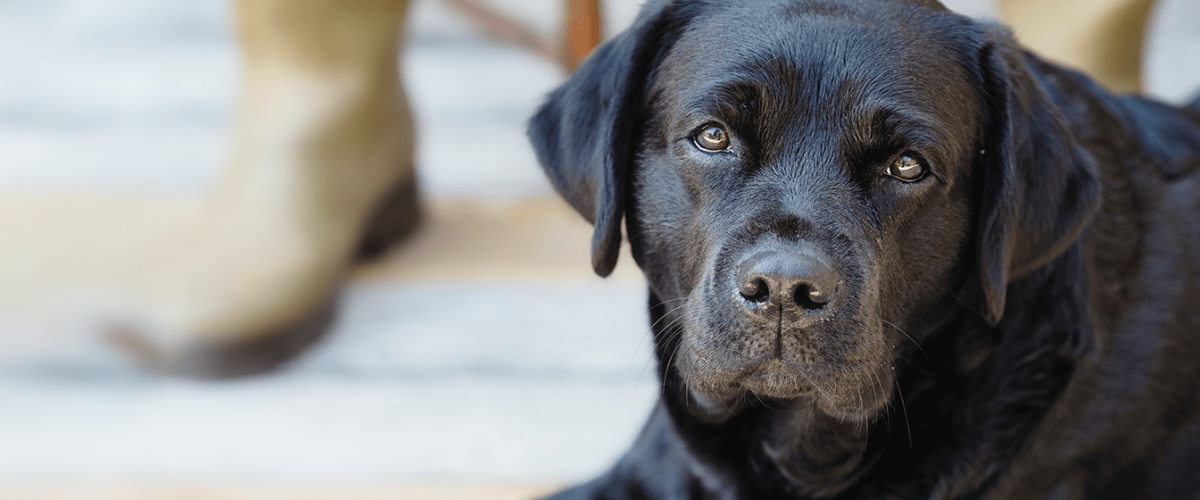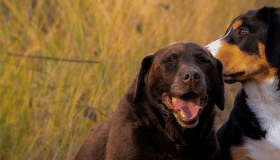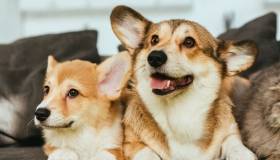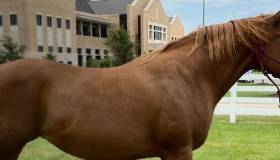
Updated August 3, 2023 – There’s a weight problem in America, and it isn’t just affecting humans. Recent statistics classify the majority of pets in the United States – about 56% of dogs and 60% of cats — as overweight or obese. Along with our house pets, an estimated 30% of horses are now considered obese, too.
What is Obesity?
Dogs are considered overweight when they weigh 10%-30% above their ideal body weight. Obesity is diagnosed when a dog’s weight exceeds 30% of their ideal body weight. Cats follow a similar standard.
What Causes Obesity in Companion Animals?
Previously, fat was considered relatively inactive tissue, simply storing excess energy calories and adding to body mass. However, new scientific evidence points to fat tissue as being biologically active and not always in a good way. Fat secretes inflammatory hormones and creates oxidative stress on the body’s tissues, both processes that contribute to many diseases. Obesity now is generally thought of as a chronic, low-level inflammatory condition.
Recent work on understanding obesity in humans has called into question something all of us have heard at one time or another – the basic equation of excess energy intake versus expenditure. However, evidence in human medicine points to other factors that play a role in the development and maintenance of obese or overweight body conditions and it is likely that similar factors affect our companion animals. These factors include genetics, breed standards, gut bacteria and owner related causes.
Knowing more about pet obesity can help owners successfully maintain a healthy weight in their companion animals. Healthy weight is important for long-term health and also a key factor in reducing the risk of many different diseases.
Genetics
Research on humans, particularly twin and adoption studies, suggests that obesity is a highly heritable trait. Observations that some dog breeds seem to have a higher tendency toward being obese suggests genetics play a role in weight gain and are consistent with the observations made in people.
For example, research conducted in the United Kingdom found that a genetic mutation was associated with overweight or obese Labrador retrievers as well as flat-coated retrievers. Interestingly, the mutation was more common in dogs from service dog lineages.
The research team theorized that dogs that were more food-motivated were easier to train as service dogs, which in turn perpetuated obesity. The team now is looking at other breeds for genetic mutations that might account for a tendency toward obesity, including golden retrievers. They are using samples from the Foundation’s Golden Retriever Lifetime Study to look for those mutations.
Another report published in 2021 by the Royal Veterinary College looked at obesity in dogs in the United Kingdom. They noted eight breeds of dogs with an increased risk of being overweight compared to crossbred dogs in the same sample group. The breeds identified were:
- Pug
- Beagle
- Golden retriever
- English springer spaniel
- Border terrier
- Labrador retriever
- Cavalier King Charles spaniel
- Cocker spaniel
The researchers concluded that owners of these dogs need to be especially vigilant about monitoring the weight of their pets.
The research on the genetics underpinning obesity in cats is a bit different. Domestic shorthaired cats – crossbred cats – were found to be at higher risk for obesity while longhaired breeds were found to be at lower risk. The risk for pure bred cats is confusing and has conflicting results. Persian cats were found to be at lower risk in one study but not in others. As our understanding of feline genetics improves, it's likely scientists will have new conclusions about obesity and genetic predisposition.
Horses, ponies and cob-type horses – horses with stout legs and sturdy builds – have a higher risk for obesity but no gene studies on equine obesity have yet been reported.
Breed Standards
Studies from the Netherlands showed a strong breed predisposition in both dogs and cats toward being overweight. Researchers proposed that not only genetics but breed standards, or ideal characteristics and appearance of a breed, could explain why certain breeds tend to be overweight. In other words, certain breed standards could be linked to obesity or promote a heavier body condition. More research needs to be done in this area, but this team suggested that breed organizations scrutinize their current breed standards and adjust as necessary.
Gut Bacteria
Interest in gut microbiome, or the community of organisms residing in the gut, has exploded in the last decade in both human and veterinary medicine. Several studies in both human and veterinary medicine have linked increased body weight to changes in the gut microbiome.
Veterinary researchers have documented a difference between the microbiome composition of obese and overweight dogs and their leaner counterparts. Studies on the cat microbiome also indicate differences between the microbiomes of obese and lean individuals. However, the question remains as to whether the gut bacteria change occurs prior to an animal becoming obese, and could be driving the weight gain, or after a dog or cat gains weight and is possibly perpetuating the weight gain.
The Foundation recently funded a study investigating why some overweight cats lose weight successfully when put on a lower-calorie or restricted diet, while others do not. Intriguing studies in mice show that giving fecal transplants from the gut of lean mice into obese mice appears to lead to weight loss in obese mice, and the opposite also appears to be true. A study in progress at The Ohio State University is looking at the effect of fecal transplantation as an adjunctive therapy for obese cats.
Owner-Related Causes
As much as people love their pets, they may unknowingly contribute to their pet’s obesity. Researchers found that increasing owner age, decreased weekly exercise hours, and lower owner income levels were all associated with a higher risk for companion animal obesity. The researchers concluded that in their study, owner-related factors were more important in the development of obesity than dog-related factors such as breed, age or reproductive status.
Studies show many owners underestimate body condition in their companion animals (dogs, cats and horses), leading to the misperception that their companion animals have a normal body condition when they’re actually overweight. The good news here is there are several validated body condition charts that are easy for veterinarians and owners to use. Many veterinary clinics now include this evaluation as part of their physical examination and often share these resources with clients to help them recognize when weight in their companion animal is becoming a problem.
Companion animal owners contribute to the overweight/obesity problem in other ways, too. A survey conducted from owners of obese and overweight dogs in the United Kingdom showed that dog owners had a variety of justifications for their dog’s body conditions, including the use of food to show affection, preferring their companion animal to be happy even if it meant a shorter life and denial that their dog was overweight at all. Changing attitudes and behaviors can be a high hurdle for a veterinary team.
Helping Your Pet Lose Weight
Obesity is one of the few diseases that companion animal owners can influence, but it’s a journey that can take many months. Maintaining weight loss requires vigilance and commitment.
Switching a dog or cat to a prescription diet that promotes weight loss remains one of the best and easiest ways to help a companion animal lose weight. Although many commercial foods are advertised as weight-reduction or “light” diets are often not as effective as prescription diets in promoting weight loss. The downside is prescription diets require a veterinarian’s recommendation and are almost always more expensive than diets purchased in most retail stores.
One study conducted with dog owners in the United Kingdom compared the cost of a prescription diet with a regular commercial diet plus treats. The researchers found that costs were roughly similar when they looked at the average amount spent. However, there was a wide range in costs per dog, with some commercial diets costing much less than a prescription diet, and some much more. This study’s finding is important because it demonstrated that, at least in some cases, feeding a prescription diet was less expensive than commercial food.
Other weight-loss strategies for dogs and cats include:
- Giving companion animals plenty of exercise and social stimulation
- Using food puzzles for feeding: They ensure slow consumption while providing stimulation
- Thoughtful timing of spaying and neutering
- Using a consistent measuring device such as a measuring cup or scale to determine portions
- Avoiding high-calorie, especially high-fat treats, even in small amounts
- Enlisting the support of the entire veterinary care team
- Avoiding assigning blame and engaging everyone in the family to help
- Being patient and compassionate – weight loss is hard!
For veterinarians, discussing weight loss with companion animal owners can be difficult. A recent review on how to effectively talk to owners about weight loss makes veterinarians feel uncomfortable. The review noted that veterinarians feel that they will “offend, upset, anger, or even lose a client” if they bring up the subject of a companion animal’s weight. If the owner or the veterinarian is overweight, the situation is even more strained.
The same review suggested enlisting the entire veterinary team to deliver consistent and clear messaging regarding weight loss. They found that the key to successful weight loss includes continual, active engagement with owners, and tailoring weight-loss strategies to fit both the companion animal and owner’s lifestyles.
Scales are not readily available to many horse owners but weight tapes can help. These items can be purchased online or at stores stocking horse care supplies. Another method to monitor weight uses a regular tape measure and a little math. For adult horses, the formula is: heart girth x heart girth x body length/330 = the weight of the horse in pounds. Either method is a great way to objectively measure and monitor weight!
The good news is that surveys suggest many owners are open to getting nutrition and diet information from their veterinarian. Kind and compassionate communication is a key to working together to address weight loss.
Why Weight-Loss Programs Fail
Weight-loss programs for companion animals fail for many reasons. Attitudes toward feeding and even body condition assessment can influence whether an owner adheres to a companion animal’s weight loss program, or even recognizes a need for weight loss.
Adhering to a weight loss plan can be challenging for owners. A study recently demonstrated that out of all the obese dogs involved in a weight loss program, about 32% dropped out before reaching their weight loss goals. The researchers couldn’t pinpoint a single cause for the dogs’ failure rate, but commonly cited reasons for dropping out included difficulty adhering to weight loss plans, lack of ongoing support, and development of other illnesses that shifted the owner’s focus.
Another project comparing different diet strategies found owners were most dissatisfied when they had to measure the food portions themselves. They reported greater hunger in their companion animals and noted accompanying behavioral changes such as increased vocalization. The team concluded that convenience and related owner perceptions of hunger behaviors could influence compliance when instituting a weight loss program.
Maintaining Weight Loss
Weight loss, whether it is in our companion animals or ourselves, is difficult to maintain. Scientists are finding that our bodies have a certain weight thermostat, and that in the face of weight loss – or even weight gain – our body will attempt to maintain a consistent weight. Although this effect can protect us from becoming overweight, the thermostat can reset to an overweight or obese condition, impacting our ability to achieve or maintain weight loss. Learning how to set the thermostat to maintain a leaner body type is the subject of an ongoing study in people and ultimately could help our companion animals as well.
More Resources
To learn more about obesity, genetics and nutrition in dogs, watch the June 2021 episode of Golden Zoomies featuring geneticist Dr. Eleanor Raffin and veterinary nutritionist Dr. Marge Chandler.
For additional information about obesity in cats and dogs, take a deeper dive with Dr. Chandler on our Fresh Scoop podcast.
To learn more about obesity in horses, listen to our Fresh Scoop podcast featuring Dr. Patricia Harris, specialist in veterinary and comparative nutrition. In this episode, Dr. Harris discusses the equine obesity epidemic and how to determine a horse’s body condition. Dr. Harris also offers advice for owners on how to help their horse lose weight, as well as strategies to prevent obesity.
And don’t forget – it’s important to talk to your veterinarian before starting any weight loss and exercise program for your dog, cat or horse. Your veterinarian can help guide the program and provide resources to ensure success!
Learn more about how you can help us to fund more studies looking at this important and serious health issue of companion animals. Your support can make a difference!




